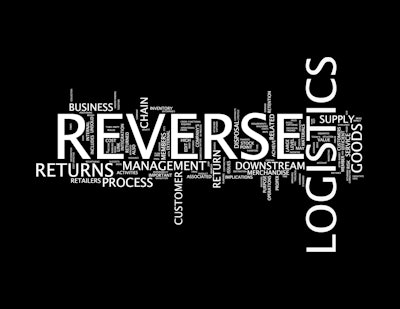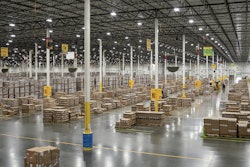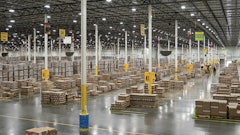
Volatile tariffs and shifting global trade policies are squeezing already thin retail margins. At the same time, consumer expectations for fast, convenient service have never been higher. Retailers are under mounting pressure to control costs without compromising loyalty.
One of the biggest, yet most overlooked levers in this equation is reverse logistics. Returns now represent a massive operational and financial burden. According to the National Retail Federation, U.S. consumers returned 16.9% of all retail purchases in 2024, worth $890 billion.
Yet the challenge is also an opportunity. The faster and more efficiently resaleable returned items can be processed, the greater the chance they re-enter inventory, protecting margin. Reverse logistics is no longer just about minimizing loss. It’s about turning a costly process into a competitive advantage.
And at the heart of this transformation is a surprisingly simple piece of infrastructure: the parcel locker.
Why lockers matter in reverse logistics
Once viewed primarily as a last-mile tool for customer deliveries, smart parcel lockers are now becoming a go-to channel for returns. Installed inside stores or outside in parking lots and along sidewalks, they give customers a secure, automated drop-off point that simplifies the process.
Here’s how it works: A shopper initiates a return online, receives a unique code, and deposits the item in the designated locker. Once the door closes, the system confirms receipt, triggers the refund process, and routes the item for pickup. Depending on SKU logic, the item may head to a local store for restocking or a distribution center for resale.
The impact is tangible:
● Faster refunds, happier customers. Automated confirmation reduces wait times, strengthening trust and loyalty. According to the same NRF report, 67% of consumers say they wouldn’t shop again with a brand where they had a negative return experience.
● Lower labor costs. By automating intake, lockers free associates from time-consuming return processing, allowing them to focus on sales and service.
● Improved resale rates. Smart routing gets items back into inventory faster, boosting the likelihood of resale before products lose value.
● Operational flexibility. Lockers require minimal footprint and can be deployed in or adjacent to stores without disrupting operations.
● Sustainability gains. Consolidated drop-offs reduce vehicle miles traveled and packaging waste, supporting ESG goals while lowering costs.
Lockers transform returns from a high-friction pain point into a streamlined, customer-friendly interaction.
The locker playbook: four strategies for smarter returns
For retailers, simply placing lockers in stores or parking lots is only the beginning. To truly capture their value, lockers need to be part of a bigger reverse logistics strategy, one that connects customer experience, labor efficiency, inventory recovery, and sustainability.
When integrated thoughtfully, lockers can shift returns from a costly obligation to a revenue- and loyalty-driving capability. Here are four ways retailers can put them to work:
- Streamline the customer journey. Returns are often bogged down by labels, boxes, and staff intervention. Lockers eliminate these pain points. Shoppers can initiate the return online, skip printing and packaging, and drop off items quickly. In-store, this reduces lines at the customer service desk; outside, lockers provide after-hours flexibility.
Apparel retailers, for example, often see “bracketing” behavior, where customers order multiple sizes and return the items that don’t fit. By moving these returns out of fitting rooms and service counters, lockers keep store traffic flowing smoothly, a major advantage during peak seasons when congestion is at its worst.
2. Reallocate store labor. Returns are a hidden labor sink. Associates spend valuable time processing items, printing labels, and explaining policies. Lockers take this work off the frontline.
In consumer electronics, lockers absorb simple returns like headphones or chargers, freeing up staff to spend more time with customers considering complex, higher-margin purchases such as laptops or home theater systems. By shifting low-value tasks away from staff, lockers help maximize labor ROI in an era of rising wage costs.
3. Map lockers for maximum convenience. Placement matters. Lockers should be where customers already are, i.e., inside the store for those who prefer personal interaction or directly outside along controlled sidewalk or parking spaces for those who want speed and independence.
Big-box retailers, for instance, can use exterior lockers in parking lots to allow after-hours returns. This extends convenience without requiring extra staff inside and helps manage in-store congestion during busy shopping periods.
4. Use data to drive smarter routing. Not all returns are equal. A basic T-shirt and a high-value electronic device shouldn’t follow the same path. Automated locker systems can batch returns by SKU, condition, or resale value, routing them to the right destination.
In home goods, lockers can route small appliances in good condition back onto local shelves for quick resale, while directing seasonal or bulky items to regional clearance centers. This minimizes handling time, reduces shipping costs, and maximizes resale potential.
Returns as infrastructure, not an afterthought
Economic pressures are intensifying. Margins are shrinking, labor is costly, and customer expectations are on the rise. Retailers that treat reverse logistics as an afterthought risk higher costs, lost loyalty, and operational drag. Those that embrace automation and agility are better positioned to navigate volatility.
Smart lockers aren’t just a convenience feature. They’re infrastructure. They automate what’s slow, accelerate what’s stalled, and build resilience where it matters most. They help protect margins, extend customer loyalty, and align with sustainability priorities.
In an environment where return volumes are rising alongside ecommerce growth and tariff uncertainty, the real question isn’t whether to optimize reverse logistics. It’s how quickly retailers can deploy solutions that transform returns from a liability into a loyalty-building asset.
Reverse logistics may once have been the unglamorous side of retail. Today, it’s the new frontier in delivery optimization, and smart lockers are proving to be the backbone of future-ready operations.



![Pros To Know 2026 [color]](https://img.sdcexec.com/mindful/acbm/workspaces/default/uploads/2025/08/prostoknow-2026-color.mduFvhpgMk.png?auto=format%2Ccompress&bg=fff&fill-color=fff&fit=fill&h=100&q=70&w=100)







![Pros To Know 2026 [color]](https://img.sdcexec.com/mindful/acbm/workspaces/default/uploads/2025/08/prostoknow-2026-color.mduFvhpgMk.png?ar=16%3A9&auto=format%2Ccompress&bg=fff&fill-color=fff&fit=fill&h=135&q=70&w=240)







